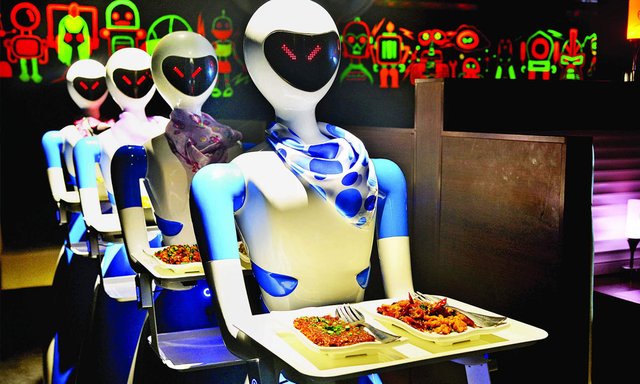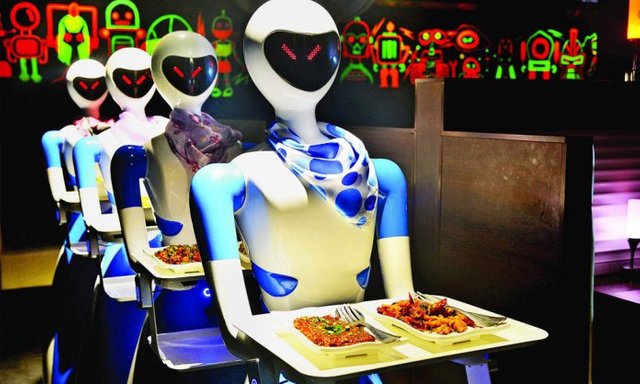Chip Labour: Robots Exchange Waiters in Eating places

The little robotic waiter wheels as much as the desk, raises its glass lid to disclose a steaming plate of native Shanghai-style crayfish and proclaims in low, mechanical tones, “Enjoy your meal.”
The futuristic restaurant idea is the most recent initiative in Chinese language e-commerce large Alibaba’s push to modernise service and retail in a rustic the place robotics and synthetic intelligence are more and more being built-in into commerce.
Elevating effectivity and decreasing labour prices are the aims at Alibaba’s “Robot.He” diners, the place waiters have been changed by robots concerning the dimension of microwave ovens, which roll across the eating room on table-high runways.
“In Shanghai, a waiter costs up to 10,000 yuan ($1,500) per month. That’s hundreds of thousands in cost every year. And two shifts of people are needed,” mentioned Cao Haitao, the Alibaba product supervisor who developed the idea.
“But we don’t need two shifts for robots and they are on duty every day.”
The diners are hooked up to Alibaba’s new Hema chain of semi-automated supermarkets, the place grocery buyers fill their “carts” on a cell app and have the merchandise dropped at them at checkout by way of conveyor tracks on the ceiling, or delivered straight to their properties.
Alibaba now has 57 Hema markets in 13 Chinese language cities, all of which is able to finally function the robotic eating places.
Trade specialists say they serve extra as showcases of Alibaba’s tech prowess than a severe enterprise mannequin in a rustic the place labour prices are comparatively low.
However the eating places additionally typify the speedy adoption of recent applied sciences in a rustic the place the federal government is more and more utilizing facial-recognition know-how to police streets and establish law-breakers.
– Automation nation –
With digital funds by way of cell phone already now rivalling money for a lot of purchases, rising numbers of pharmacies, bookstores and different retailers have disbursed with cashiers, permitting clients to order and pay for his or her desired merchandise, which is usually handed over by a robotic.
Alibaba’s e-commerce rival JD.com has introduced plans to open 1,000 eating places by 2020 through which meals can be ready and served by robots.
JD.com and others are additionally working to include airborne drones into their supply networks.
The motion might assist firms cut back prices as development charges in China’s e-commerce growth start to plateau.
“Before, everyone was all going for rapid expansion. Now the growth is gone and everyone has to focus on improving their operations,” mentioned Jason Ding, a China retail skilled with Bain & Firm.
“Operation is all about cutting costs and providing better service. So these automated machine technologies, in the right place, can play a role there.”
At Robotic.He, clients guide tables and order entrées by way of apps, and the diner’s novelty typically attracts lengthy queues.
Ma Yiwen, 33, introduced almost a dozen colleagues together with her.
“We are all foodies and we use our lunch time to try good food near our office. The idea of a robot delivering food to our table is very innovative so we wanted to see it ourselves,” she mentioned.
The restaurant says automation helps maintain prices down, an extra lure for 20-year-old buyer Ma Shenpeng, who comes as soon as per week.
“Normally for two to three people, a meal costs about 300-400 yuan, but here, all this table of food is just over 100 yuan,” he mentioned.
Chinese language AI advocates predict robots will sometime carry out a variety of mundane duties as dwelling requirements rise, from supply to sweeping flooring and offering companionship, notably as China’s labour pressure has shrunk as a result of not too long ago relaxed one-child inhabitants management coverage.
However it’s a fragile difficulty for Chinese language policy-makers as a result of potential for human job losses, and the federal government is within the midst of a long-term push to develop the nation’s providers trade partly as a job creator, as manufacturing more and more turns into mechanized.
Wang Hesheng, a robotics professor at Shanghai’s Jiaotong College, mentioned the price of robots stays too excessive for widespread client use and that many firms had been merely leaping on the federal government’s high-tech bandwagon.
However robotics might unfold if China labour prices proceed to develop, he mentioned.
“Maybe when labour costs rise higher and higher, robots will balance out with humans,” he mentioned.
